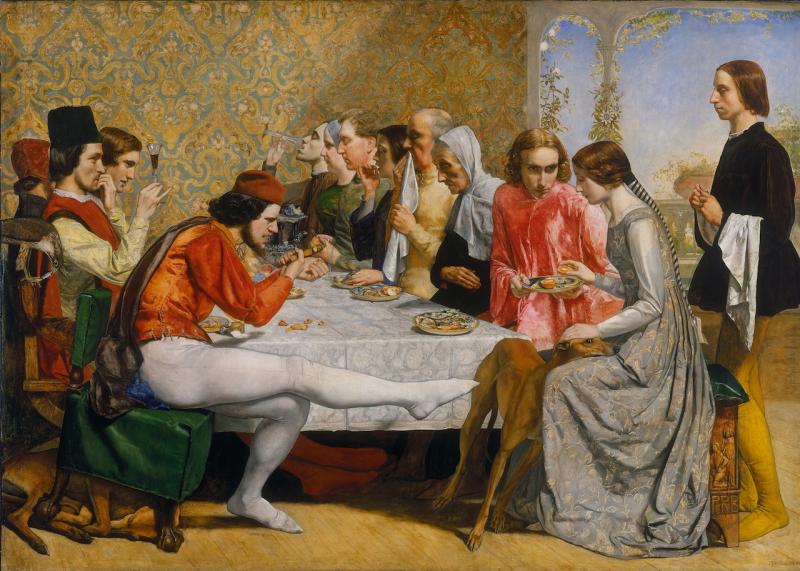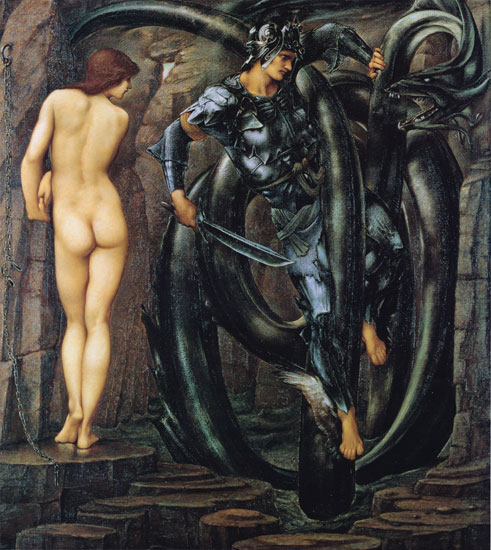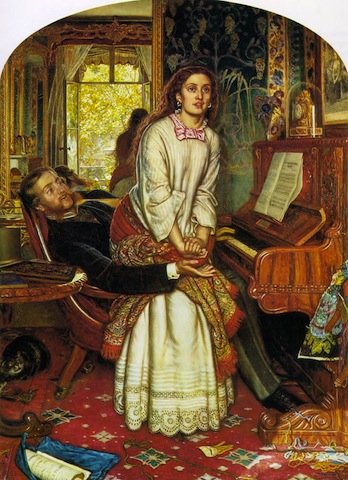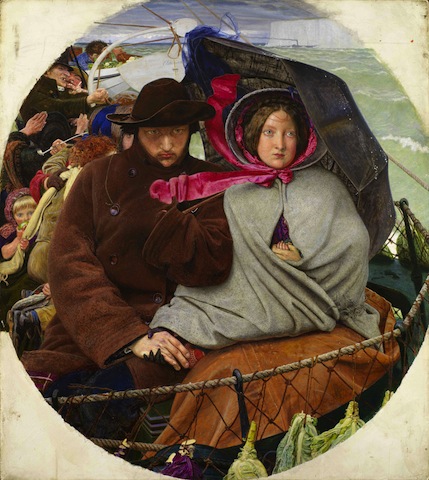Pre-Raphaelites: Victorian Avant-Garde, Tate Britain | reviews, news & interviews
Pre-Raphaelites: Victorian Avant-Garde, Tate Britain
Pre-Raphaelites: Victorian Avant-Garde, Tate Britain
For all the fervent propaganda for the modernity of the art, the elaborate set pieces of myth and legend still look ridiculous

The vividly dramatic story of Isabella, from a poem by Keats (in turn from Boccacio’s Decameron,) crying over her lover Lorenzo, who, base born, was murdered by her brothers, was much admired by the Victorians. The tale is not for the squeamish: the widowed mistress resolutely dug up the corpse and detached the head, which she then buried in a pot of basil.
The story inspired two founder Pre-Raphaelite painters, William Holman Hunt and John Everett Millais (main picture), and both are on view in this anthology of High Victorian art by the original seven PRBs, their peer group, colleagues and followers. The Pre-Raphaelites determined to go back to a purity of painting they thought resided in medieval and early Renaissance times, before the art of Raphael. The brotherhood was founded in 1848, a year pregnant with riots and revolutions, and their publication The Germ (hoping their ideas would be contagious) followed in 1850.
 Hundreds of stories captivated Hunt and Millais, who were young, eager, and obsessively hard working and productive artists. They had met each other as well as Dante Gabriel Rossetti while studying at the Royal Academy Schools. The walls of Tate are covered with endless scenes from Shakespeare – Millais’ drowned Ophelia, decorated with flowers, for which Lizzie Siddall posed in her bath, is not only a mesmerizingly detailed image but among the Tate’s most popular postcards – and Arthurian legend, in tapestries designed by Burne Jones of chivalric knights and the worship of the Holy Grail (image right: Burne-Jones, Perseus Slaying the Dragon, 1884-85).
Hundreds of stories captivated Hunt and Millais, who were young, eager, and obsessively hard working and productive artists. They had met each other as well as Dante Gabriel Rossetti while studying at the Royal Academy Schools. The walls of Tate are covered with endless scenes from Shakespeare – Millais’ drowned Ophelia, decorated with flowers, for which Lizzie Siddall posed in her bath, is not only a mesmerizingly detailed image but among the Tate’s most popular postcards – and Arthurian legend, in tapestries designed by Burne Jones of chivalric knights and the worship of the Holy Grail (image right: Burne-Jones, Perseus Slaying the Dragon, 1884-85).
And of course Biblical scenes figure large, including Millais’ scandalously realistic depiction of the young Christ as a carpenter in Joseph’s workshop. On view is Holman Hunt’s dying goat, indeed a scapegoat, tethered in the Dead Sea - Hunt spent time in Palestine to ensure that his depiction of the landscape was as accurate as possible - as is the melodramatic The Light of the World, the looming Christ figure behaloed, crowned and garbed in gold. Hunt’s The Finding of the Saviour in the Temple is elaborate, a kind of collage of painstaking observation: the synagogue modelled on an English replica of the Alhambra, peopled by Jewish elders, with the young Christ evidently partly based on a young Etonian when Hunt was back in London.
The exhibition is really the painted word, practically every image the visualisation of an elaborate plot. It makes Renaissance painting look positively simple. The captions are unusually detailed, just to help the visitor along.
 Some of the stories are of course the artists’ invention: Hunt’s The Awakening Conscience (image left) shows a well kept young mistress suddenly almost tragically aware of the limitations of her position, with all kinds of clues in the dress and pose of mistress and lover in a middle-class sitting room, stuffed with objects. In fact almost all the paintings are packed with stultifying details: the women and men are dressed with an almost grotesque opulence, and rarely can textiles have been so elaborately patterned, their textures from wool to silk so patiently observed. The women are bejewelled, walls and floors are richly patterned, carpets and rugs lovingly portrayed, there are scores of plants in the gardens, many with symbolic meanings. More is more.
Some of the stories are of course the artists’ invention: Hunt’s The Awakening Conscience (image left) shows a well kept young mistress suddenly almost tragically aware of the limitations of her position, with all kinds of clues in the dress and pose of mistress and lover in a middle-class sitting room, stuffed with objects. In fact almost all the paintings are packed with stultifying details: the women and men are dressed with an almost grotesque opulence, and rarely can textiles have been so elaborately patterned, their textures from wool to silk so patiently observed. The women are bejewelled, walls and floors are richly patterned, carpets and rugs lovingly portrayed, there are scores of plants in the gardens, many with symbolic meanings. More is more.
The search for verisimilitude was obsessive, the labour intensive, and many of the paintings, until the soft focus of Burne-Jones’ ethereal maidens, are characterised by blazing acid bright colours, hard edged objects and an overall focus, a blade of grass as sharply delineated as a central heroic figure. No atmospheric lighting , everything is under a glare, long before spotlights were invented.
Victorian art in general and the Pre-Raphaelites in particular were widely and wildly successful in terms of prestige and financial reward in their own time, some as celebrated if not more so than the YBAs. But for long periods in the 20th century their work could be bought for practically nothing, and Victorian aesthetics provoked critical condemnation. By the post-war period, critics, scholars and dealers had rallied. From the captivating early books by William Gaunt, the foundation of the Victorian Society in 1958, the pioneering commercial efforts of the determined dealer Jeremy Maas, and such galleries as the Fine Art Society, the host of terrific recent biographies, among them Fiona McCarthy’s William Morris, and just this year, her Edward Burne-Jones, with auction houses not too far behind, the art that was once the subject of sustained ridicule is now revered in some quarters.
There have been significant exhibitions at the Victoria and Albert, from William Morris in 1996 to The Cult of Beauty in 2011. The Tate’s last survey of the PreRaphaelites was in 1984, when painting stood alone unlike this showing which combines the fine and decorative arts.
Seven galleries are filled, indeed jammed, with paintings, watercolours, drawings, illustrated books, furniture, tapestries, stained glass, photographs and even William Morris’s bed complete with elaborate hangings and bedcover. It is an astonishing array of work, and, demonstrating an international level of interest in the period, the exhibition is travelling to the National Gallery of Art in Washington, and on to Moscow and Tokyo. There is an argument as well that the PreRaphaelites and their followers were actually part of a conscious avant-garde as they originally defied the establishment (however many knighthoods were eventually bestowed). And certainly the artists strongly engaged with contemporary issues – Ford Madox Brown’s Work, bringing together representatives of all of society’s different strata in an implausible crowd in Hampstead High Street, Henry Wallis’ The Stonebreaker, depicting the death in deserted wooded landscape of an oppressed rural labourer, a stoat crawling over his boot.
 To this viewer, the elaborate set pieces of myth, legend and literary narratives, for all the fervent propaganda for the modernity of the art, still look ridiculous. When purporting to show real events, the costume dramas of course romanticise and even sanitise the past. Every personage is a handsome specimen, fresh-faced, bursting with energy. The genuine emotion though in some of the portraits – Burne Jones unfinished portrayal of his wife Georgiana, serene in the face of continuous domestic difficulty, Ford Madox Brown’s marvellous The Last of England (image right) its subject a young couple setting forth for Australia – crashes through the ludicrous preoccupations with the dressing-up box that make so many of the fantastical historical constructions mildly absurd. And some of the comparatively straightforward landscapes, for example Ford Madox Brown’s rooftops and gardens in Hampstead, are replete with quiet beauty.
To this viewer, the elaborate set pieces of myth, legend and literary narratives, for all the fervent propaganda for the modernity of the art, still look ridiculous. When purporting to show real events, the costume dramas of course romanticise and even sanitise the past. Every personage is a handsome specimen, fresh-faced, bursting with energy. The genuine emotion though in some of the portraits – Burne Jones unfinished portrayal of his wife Georgiana, serene in the face of continuous domestic difficulty, Ford Madox Brown’s marvellous The Last of England (image right) its subject a young couple setting forth for Australia – crashes through the ludicrous preoccupations with the dressing-up box that make so many of the fantastical historical constructions mildly absurd. And some of the comparatively straightforward landscapes, for example Ford Madox Brown’s rooftops and gardens in Hampstead, are replete with quiet beauty.
The show is a major milestone in the continuing revaluation of Victorian art in England, and opening as the Olympic summer has ended, oddly patriotic. But although it proposes a leading role as an avant-garde for this British art, the high seriousness is often unintentionally comic – although the truly wild colour combinations and dazzling patterns could teach fashion a thing or two. Will we see Pre-Raphaelite dress on the high street?
Pre-Raphaelites: Victorian Avant-Garde at Tate Britain until 15 January
Explore topics
Share this article
The future of Arts Journalism
You can stop theartsdesk.com closing!
We urgently need financing to survive. Our fundraising drive has thus far raised £49,000 but we need to reach £100,000 or we will be forced to close. Please contribute here: https://gofund.me/c3f6033d
And if you can forward this information to anyone who might assist, we’d be grateful.

Subscribe to theartsdesk.com
Thank you for continuing to read our work on theartsdesk.com. For unlimited access to every article in its entirety, including our archive of more than 15,000 pieces, we're asking for £5 per month or £40 per year. We feel it's a very good deal, and hope you do too.
To take a subscription now simply click here.
And if you're looking for that extra gift for a friend or family member, why not treat them to a theartsdesk.com gift subscription?
more Visual arts
 'We are bowled over!' Thank you for your messages of love and support
Much-appreciated words of commendation from readers and the cultural community
'We are bowled over!' Thank you for your messages of love and support
Much-appreciated words of commendation from readers and the cultural community
 Folkestone Triennial 2025 - landscape, seascape, art lovers' escape
Locally rooted festival brings home many but not all global concerns
Folkestone Triennial 2025 - landscape, seascape, art lovers' escape
Locally rooted festival brings home many but not all global concerns
 Sir Brian Clarke (1953-2025) - a personal tribute
Remembering an artist with a gift for the transcendent
Sir Brian Clarke (1953-2025) - a personal tribute
Remembering an artist with a gift for the transcendent
 Emily Kam Kngwarray, Tate Modern review - glimpses of another world
Pictures that are an affirmation of belonging
Emily Kam Kngwarray, Tate Modern review - glimpses of another world
Pictures that are an affirmation of belonging
 Kiefer / Van Gogh, Royal Academy review - a pairing of opposites
Small scale intensity meets large scale melodrama
Kiefer / Van Gogh, Royal Academy review - a pairing of opposites
Small scale intensity meets large scale melodrama
 Jenny Saville: The Anatomy of Painting, National Portrait Gallery review - a protégé losing her way
A brilliant painter in search of a worthwhile subject
Jenny Saville: The Anatomy of Painting, National Portrait Gallery review - a protégé losing her way
A brilliant painter in search of a worthwhile subject
 Abstract Erotic, Courtauld Gallery review - sculpture that is sensuous, funny and subversive
Testing the boundaries of good taste, and winning
Abstract Erotic, Courtauld Gallery review - sculpture that is sensuous, funny and subversive
Testing the boundaries of good taste, and winning
 Edward Burra, Tate Britain review - watercolour made mainstream
Social satire with a nasty bite
Edward Burra, Tate Britain review - watercolour made mainstream
Social satire with a nasty bite
 Ithell Colquhoun, Tate Britain review - revelations of a weird and wonderful world
Emanations from the unconscious
Ithell Colquhoun, Tate Britain review - revelations of a weird and wonderful world
Emanations from the unconscious
 Rachel Jones: Gated Canyons, Dulwich Picture Gallery review - teeth with a real bite
Mouths have never looked so good
Rachel Jones: Gated Canyons, Dulwich Picture Gallery review - teeth with a real bite
Mouths have never looked so good
 Yoshitomo Nara, Hayward Gallery review - sickeningly cute kids
How to make millions out of kitsch
Yoshitomo Nara, Hayward Gallery review - sickeningly cute kids
How to make millions out of kitsch
 Hamad Butt: Apprehensions, Whitechapel Gallery review - cool, calm and potentially lethal
The YBA who didn’t have time to become a household name
Hamad Butt: Apprehensions, Whitechapel Gallery review - cool, calm and potentially lethal
The YBA who didn’t have time to become a household name

Add comment